Kiptopeke State Park: more species than you can shake a stick at, tons of history, and sometimes, the fish even jump right into the boat—what more could you ask for?!

Two years ago, some of the PropTalk/FishTalk crew headed south to fish the concrete ships at Kiptopeke State Park in Cape Charles, VA, and it was one of the most fun and productive fishing days of the whole year. This year, we decided early on that we had to return.
History Refresher
For those not familiar, the Kiptopeke breakwater is made up of nine concrete ships, partially sunken, and lined up end-to-end just offshore. They are close enough to paddle to; just be sure to stay around the perimeter and do not attempt to go in between any of the vessels. But just how did the ships end up here?
World War II had led to a scarcity in steel, but concrete was cheap. So, in 1942, the U.S. Maritime Commission ordered 24 ships to be built, and the contract was awarded to McCloskey and Co. in Tampa, FL. These ships served throughout World War II and two even saw combat. After the war ended, nine ships were scuttled in 1948 to protect the Little Creek-Cape Charles Ferry terminal. All nine previously served as transport and training vessels in the South Pacific.
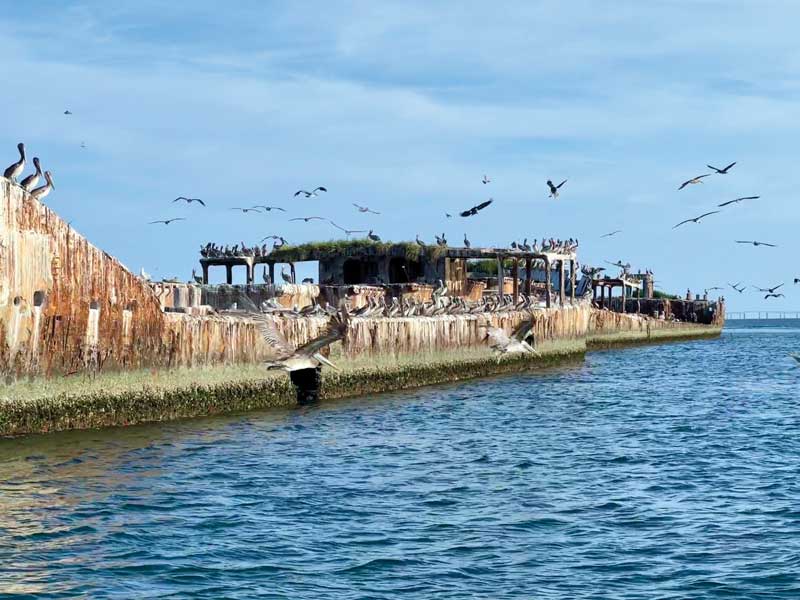
When the Chesapeake Bay-Bridge Tunnel was completed in 1964, the ferry terminal was no longer needed at Kiptopeke and eventually closed, but the breakwater remains. Similar to the allure held by the Ghost Fleet of Mallows Bay, the concrete ships stand guard over the Kiptopeke beach, their rusting hulks partially submerged and overtaken by the sea. Personally, it’s one of the coolest and unique places I’ve ever fished on the Chesapeake Bay.
Where To Stay
Anglers have the option to stay directly at Kiptopeke State Park, which offers two and three-bedroom cabins, six-bedroom lodges, RV and tent camping, yurts, and a bunkhouse. Other facilities/attractions include a boat ramp, lighted fishing pier, picnic areas, five miles of hiking and biking trails, a playground, a beach bathhouse, and swimming beach. Seasonal interpretive and educational programs focused on natural history, birding, and Bay ecology are also available.
Our group opted to stay at an Airbnb, and honestly, I can’t recommend this place enough. The Ladybug in Cape Charles is located just minutes from the Kiptopeke boat ramp, so you can’t beat the convenience factor. And apart from being a beautiful house in an idyllic location, it’s the perfect setup for anglers with plenty of space to park a trailer, plug in, and clean your boat, and it even has a fish-cleaning station.
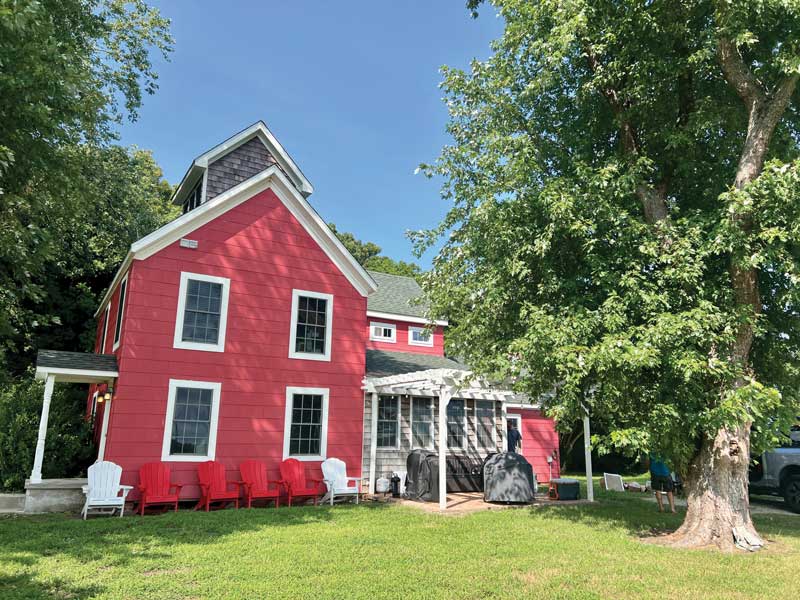
The three bedroom, three-and-a-half bath farmhouse is surrounded by Magothy Bay State Natural Area Preserve with views of the surrounding farmlands. It was quiet and as peaceful as could be. It’s also one of the most well-stocked Airbnb’s I’ve ever stayed at. But of course, our group’s favorite feature was the 80s retro video game arcade. I’m talking Ms. Pac Man, Galaga, Asteroids, Street Fighter 2, and more. When we weren’t too exhausted after a full day of fishing, you know that’s where we were. To find the listing, simply type “the ladybug Airbnb” into your search bar.

Species To Target
Prior to heading out, we had a few target species in mind, namely cobia, sheepshead, and bull red drum. In total, we caught 11 different species over three days, fishing from the concrete ships to the Chesapeake Bay Bridge-Tunnel and in the marshy shallows around Kiptopeke. We struck out sight-fishing for cobia, even though we did see a few, and also sheepshead. Around the bridge tunnel we hooked up with Spanish mackerel, bluefish, and flounder, but just as it was two years ago, the majority of the action we saw was right off the ships.


Towards the end of day one I was bouncing my lure on bottom (a five-inch skirted Z-Man paddletail on a jig head), just off the final ship on the left, straight out from the boat ramp, when I felt a different sort of bite. It was subtle at first, and I thought I had snagged a ray (yikes), when Lenny called out “It’s a big giant bull!” and the drag started screaming.
In Virgina, the limit is three redfish per person, per day between 18 and 26 inches in length. Fish over 30 inches are commonly referred to as “bulls.”

My adrenaline immediately kicked into high gear as I fought to safely bring the fish into the boat. The entire time my emotions swayed between ‘that’s the biggest fish I’ve ever seen!’ mega excitement and fear that after all of that, it would come unbuttoned before I could land it. Thankfully the Angler in Chief, Lenny Rudow, is an amazing and patient teacher and talked me through how to adjust to the fish’s frenetic movements, and he also netted the beastly fish. At 42.5 inches, it was my first bull red drum and my PB fish ever! It was also the first bull red of the trip, and even though Zach Ditmars outstaged me later, I’m holding on to that achievement.
Now about Zach’s fish… I can forgive him for breaking my record because it was a pretty crazy story. At the end of day two, after prospecting for hours around the Bridge-Tunnel, we returned to the concrete ships for one last go before sundown. Similar to my hookup, Zach wasn’t sure what he had at first. Our group was knee-deep in a cutlassfish frenzy (more on that later), when he stopped to take a photo of Dillon Waters’s fish with his rod still in the water. When he went to reel in, he initially thought he had snagged bottom. Then he thought the spot-lock had been disengaged and asked Lenny, “Are we moving?”
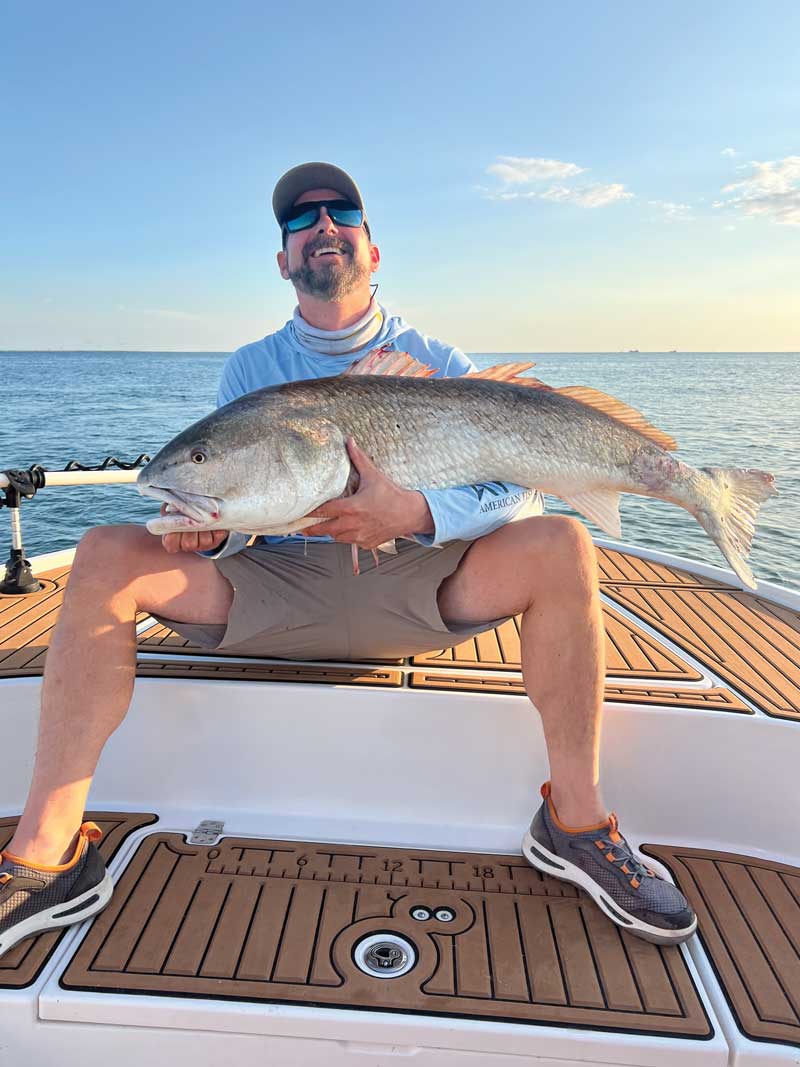
It was at that moment that Zach’s drag began to scream, and line was peeling off his reel so fast we thought it was going to completely unspool. Lenny disengaged the spot-lock, and we ran down the fish. After another impressive fight, Eric Packard successfully netted the 49-incher—Zach’s PB, and the biggest fish of the trip. But the really crazy part? That big, beautiful fish was caught on a Coach pink spoon using only 20-pound test—undersized to say the least. And just as Eric was netting the fish, the line broke, but thankfully it was already in the boat. Both Zach’s and my bull reds were safely released after a quick photo.
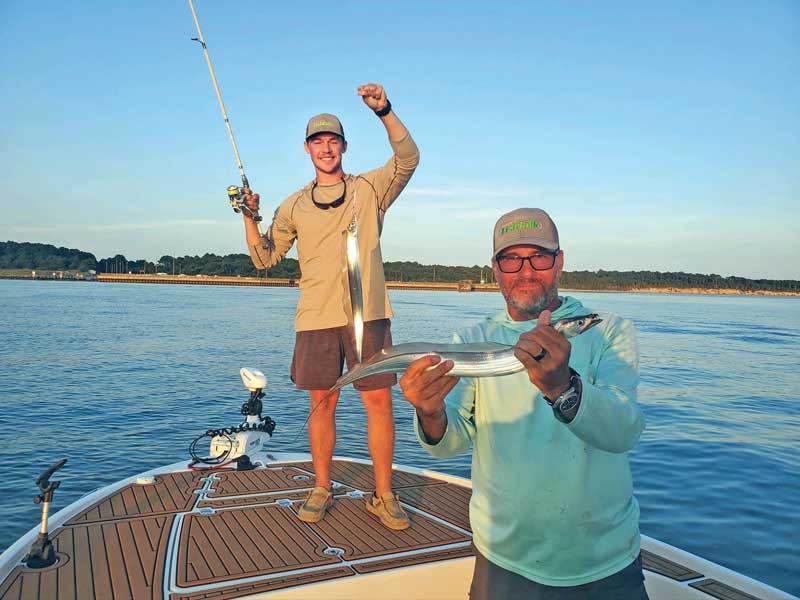
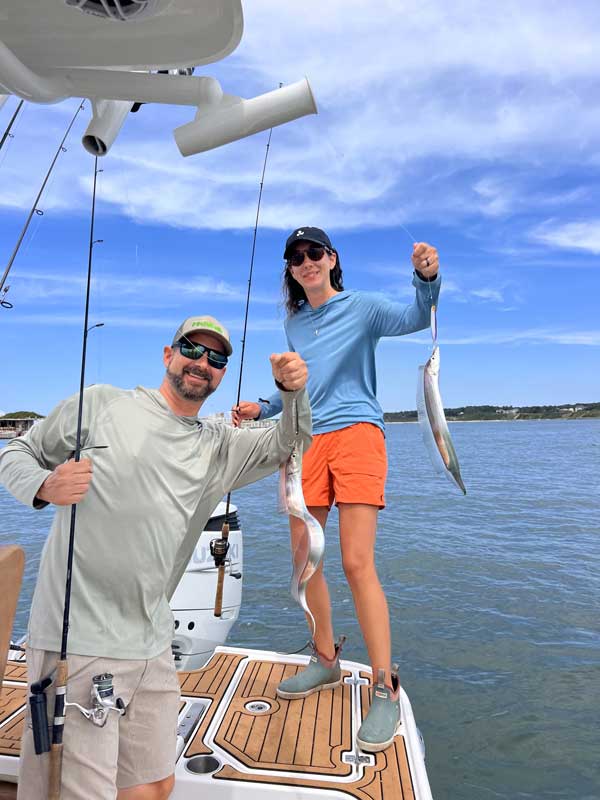
I mentioned earlier that this all started during a cutlassfish frenzy. While the bull reds were some of the biggest and most exciting catches of the trip, the cutlassfish were by far the zaniest. Each evening, right around sunset like clockwork, a feeding frenzy would begin. Swarms of cutlassfish were jumping out of the water chasing bait. And when I say zany, they were not only slamming themselves into the concrete ships, but they were also jumping into our boat one after another. The water all around us was exploding with fish. So, Lenny being Lenny, he tried to free net them, and what do you know, it worked!
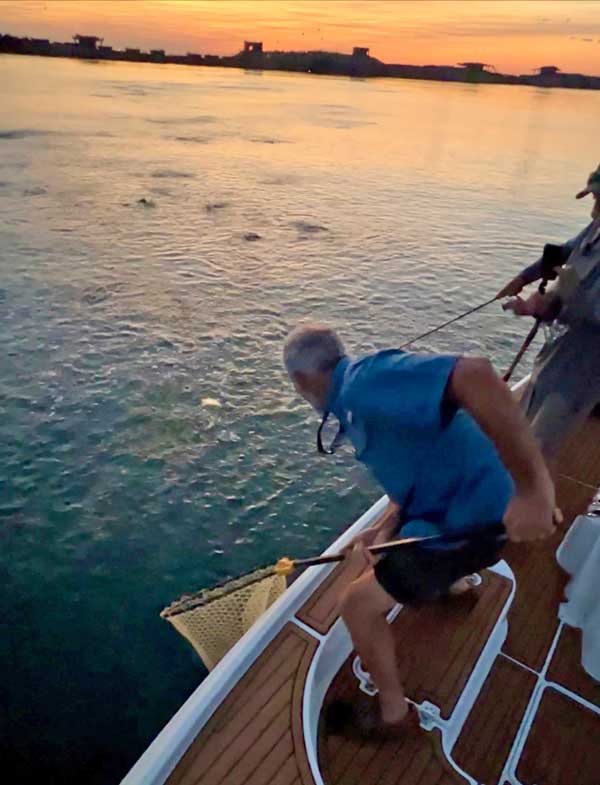
By the end of the weekend, our group of six left town with enough fish fillets to feed an army and some great memories to hold us over during the long, cold winter.
If planning your own trip to Kiptopeke, be sure to visit FishTalkmag.com for detailed how-tos for targeting specific species, as well as some tasty recipes if you find success (I can personally vouch for Lenny’s Cutlassfish pinwheel recipe-mhmm). Until next year!
By Kaylie Jasinski